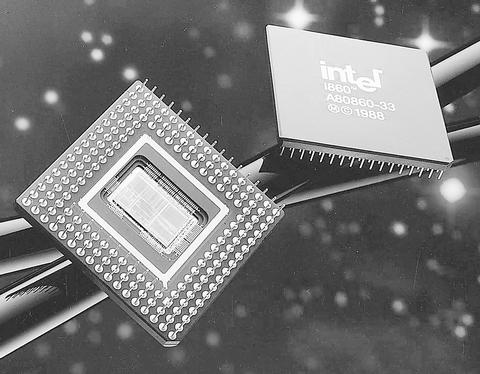NASA needs parts no one makes anymore.
So to keep the shuttles flying, the space agency has begun trolling the Internet -- including Yahoo and eBay -- to find replacement parts for electronic gear that would strike a home computer user as primitive.
Officials say the agency recently bought a load of outdated medical equipment so it could scavenge Intel 8086 chips a variant of which powered IBM's first personal computer, in 1981.

PHOTO: NY TIMES
When the first shuttle roared into space that year, the 8086 played a critical role, at the heart of diagnostic equipment that made sure the shuttle's twin booster rockets were safe for blastoff.
Today, more than two decades later, booster testing still uses 8086 chips, which are increasingly scarce. NASA eventually plans to create a US$20 million automated checking system, with all new hardware and software. In the meantime, it is finding and hoarding 8086s so that a failed one does not ground the nation's fleet of aging spaceships.
The same is true of other obsolescent parts, dozens of them.
"It's like a scavenger hunt," said Jeff Carr, a spokesman for the US Alliance, the Houston company that runs the shuttle fleet. "It takes some degree of heroics."
Troves of old parts that NASA uncovers and buys, officials said, are used not in the shuttles themselves but in flotillas of servicing and support gear. Such equipment is found, and often repaired, at major shuttle contractors around the nation, as well as at the Kennedy Space Center in Florida, where the shuttles blast into orbit.
That old computer in your basement? NASA is not interested. The agency and its contractors do not buy equipment from individuals but instead use Web searches as a way of finding stockpiles of old parts. They then buy them in bulk for repairing old machinery and building inventories of spare parts.
Recent acquisitions include outdated computer chips, circuit boards and 8-inch floppy-disk drives. "One missing piece of hardware can ruin our day," said Mike Renfroe, director of shuttle logistics planning for the United Space Alliance at the Kennedy Space Center. Recently, Renfroe said, his team swept the Internet to find an obsolete circuit board used in testing the shuttle's master timing unit, which keeps the spaceships' computers in sync. None could be found. A promising lead turned false. Finally, a board was found. It cost US$500.
"That's very inexpensive," Renfroe said. "To hire a design engineer for even one week would cost more than that."

TRAGEDY STRIKES TAIPEI: The suspect died after falling off a building after he threw smoke grenades into Taipei Main Station and went on a killing spree in Zhongshan A 27-year-old suspect allegedly threw smoke grenades in Taipei Main Station and then proceeded to Zhongshan MRT Station in a random killing spree that resulted in the death of the suspect and two other civilians, and seven injured, including one in critical condition, as of press time last night. The suspect, identified as a man surnamed Chang Wen (張文), allegedly began the attack at Taipei Main Station, the Taipei Fire Department said, adding that it received a report at 5:24pm that smoke grenades had been thrown in the station. One man in his 50s was rushed to hospital after a cardiac arrest

SAFETY FIRST: Double the number of police were deployed at the Taipei Marathon, while other cities released plans to bolster public event safety Authorities across Taiwan have stepped up security measures ahead of Christmas and New Year events, following a knife and smoke bomb attack in Taipei on Friday that left four people dead and 11 injured. In a bid to prevent potential copycat incidents, police deployments have been expanded for large gatherings, transport hubs, and other crowded public spaces, according to official statements from police and city authorities. Taipei Mayor Chiang Wan-an (蔣萬安) said the city has “comprehensively raised security readiness” in crowded areas, increased police deployments with armed officers, and intensified patrols during weekends and nighttime hours. For large-scale events, security checkpoints and explosives

A car bomb killed a senior Russian general in southern Moscow yesterday morning, the latest high-profile army figure to be blown up in a blast that came just hours after Russian and Ukrainian delegates held separate talks in Miami on a plan to end the war. Kyiv has not commented on the incident, but Russian investigators said they were probing whether the blast was “linked” to “Ukrainian special forces.” The attack was similar to other assassinations of generals and pro-war figures that have either been claimed, or are widely believed to have been orchestrated, by Ukraine. Russian Lieutenant General Fanil Sarvarov, 56, head

PUBLIC SAFETY: The premier said that security would be tightened in transport hubs, while President Lai commended the public for their bravery The government is to deploy more police, including rapid response units, in crowded public areas to ensure a swift response to any threats, President William Lai (賴清德) said yesterday after a knife attack killed three people and injured 11 in Taipei the previous day. Lai made the remarks following a briefing by the National Police Agency on the progress of the investigation, saying that the attack underscored the importance of cooperation in public security between the central and local governments. The attack unfolded in the early evening on Friday around Taipei Main Station’s M7 exit and later near the Taipei MRT’s Zhongshan